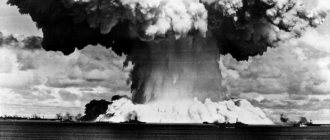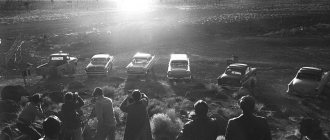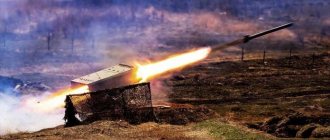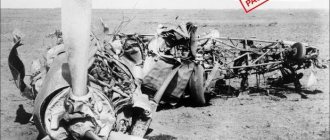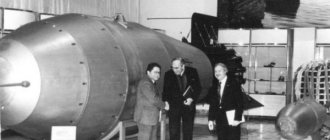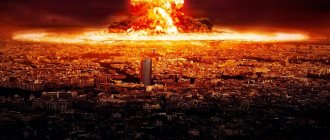Is it possible to survive the immediate consequences of a nuclear explosion? Will you die instantly, or will your death be slow and painful? It may be a painful thought, but knowing how a nuclear explosion affects the body and how to protect yourself could save your life.
Many factors determine how a nuclear explosion will affect you. The size of the bomb, whether it explodes in the air or on the ground, the geographic location of where the bomb hits, how far you are from the center of the explosion, and what types of buildings and materials are nearby all play into how a nuclear attack might affect you .
If you are at the epicenter, the explosion will destroy you
Anyone at the epicenter of the explosion—the point directly above or below the detonation—is unlikely to survive. According to Brooke Buddemeier, a health physicist at Lawrence Livermore National Laboratory, the only people who could walk through a nuclear explosion at such close range are those in a fortified building or underground bunker.
If you are unlucky enough to be in one of these safe locations and you are still within a few kilometers of the bomb, your body will instantly be reduced to its essential minerals by the explosion. It can reach up to 300,000 degrees Celsius - 300 times hotter than the temperature used to cremate human bodies.
Luckily, this will happen so quickly that you won't even notice it happening.
Life is like a struggle
When a bomb fell on Nagasaki, 16-year-old Sumiteru Taniguchi was delivering mail on his bicycle. In his own words, he saw something similar to a rainbow, then the blast wave threw him off his bicycle to the ground and destroyed nearby houses.
Photo: Hidankyo Shimbun
After the explosion, the teenager remained alive, but was seriously injured. The flayed skin hung in shreds from his arms, and there was no skin at all on his back. At the same time, according to Sumiteru Taniguchi, he did not feel pain, but his strength left him.
With difficulty he found other victims, but most of them died the night after the explosion. Three days later, Sumiteru Taniguchi was rescued and sent to the hospital.
In 1946, an American photographer took the famous photograph of Sumiteru Taniguchi with terrible burns on his back. The young man's body was mutilated for life
For several years after the war, Sumiteru Taniguchi could only lie on his stomach. He was released from the hospital in 1949, but his wounds were not properly treated until 1960. In total, Sumiteru Taniguchi underwent 10 operations.
The recovery was aggravated by the fact that at that time people were faced with radiation sickness for the first time and did not yet know how to treat it.
The tragedy he experienced had a huge impact on Sumiteru Taniguchi. He devoted his entire life to the fight against the proliferation of nuclear weapons, becoming a well-known activist and chairman of the Council of Victims of the Nuclear Bombing of Nagasaki.
Today, 84-year-old Sumiteru Taniguchi gives lectures around the world on the terrible consequences of using nuclear weapons and why they should be abandoned.
No statute of limitations. Russia wants a tribunal for Hiroshima and Nagasaki Read more
Wind can kill you if you are within a few kilometers radius
If you are within a few kilometers of the explosion and somehow survive the explosion, fusion radiation, shock wave and ultraviolet light, you are still not safe. Winds from the explosion could travel at more than 400 mph—twice the speed of a Category 5 hurricane.
The human body can withstand this force, but it cannot survive if large flying debris hits with such speed. This wind speed is enough to knock down most structures, so even if you are indoors and protected from the initial radiation, it may not matter—the building could crush you when it collapses.
Hiroshima and Nagasaki. Consequences of the explosion. Comparison of damage quality
It is worth noting that Nagasaki, despite its military and industrial significance at the time of the explosion in Hiroshima, was a rather narrow strip of coastal areas, extremely densely built up exclusively with wooden buildings. In Nagasaki, the hilly terrain partially extinguished not only the light radiation, but also the shock wave.
Specialist observers noted in the report that in Hiroshima, from the site of the epicenter of the explosion, the entire city could be seen like a desert. In Hiroshima, the explosion melted roof tiles at a distance of 1.3 km; in Nagasaki, a similar effect was observed at a distance of 1.6 km. All flammable and dry materials that could ignite were ignited by the light radiation of the explosion at a distance of 2 km in Hiroshima, and 3 km in Nagasaki. All overhead electrical lines were completely burned out in both cities in a circle with a radius of 1.6 km, trams were destroyed within 1.7 km, and damaged within 3.2 km. Gas tanks at a distance of up to 2 km suffered extensive damage. Hills and vegetation burned in Nagasaki up to 3 km.
From 3 to 5 km, the plaster from the remaining walls completely crumbled, and fires consumed all the internal contents of large buildings. In Hiroshima, the explosion created a circular area of scorched earth with a radius of up to 3.5 km. In Nagasaki the picture of fires was slightly different. The wind fanned the fire until it reached the river.
According to the commission's calculations, the nuclear explosion of Hiroshima destroyed about 60 thousand out of 90 thousand buildings, which is 67%. In Nagasaki - 14 thousand out of 52, which was only 27%. According to reports from the Nagasaki municipality, 60% of the buildings remained undamaged.
Radiation
One of the biggest long-term consequences of a nuclear explosion is radiation, not just what is deposited during fallout. If you are close to the initial explosion and survive, it means you are contaminated by radiation.
Radiation can cause chemical changes in your DNA in high enough doses, and if you are close to a nuclear explosion, these levels can be lethal, damaging or killing your cells. Radiation can cause immediate burns (including fatal ones) and can also lead to cancer.
Under what conditions does Russia use nuclear weapons?
Our country is a nuclear power, so the editors paid special attention to the situation of atomic weapons in Russia. On June 2 of this year, Vladimir Putin signed a decree on “nuclear deterrence.” It states that nuclear war will begin if:
- reliable information will be received about the launch of nuclear missiles towards Russia or allied countries;
- the bomb will actually fall (unexpectedly) on Russia or allied countries;
- There will be attacks on military installations that are responsible for responding to a nuclear attack:
- there will be a conventional attack (without the use of an atom), which will threaten the existence of the state.
In mid-April, the US State Department accused Russia of violating the terms of the nuclear testing treaty. According to American intelligence, Russia violated regulations during nuclear tests. Russian Foreign Minister Sergei Ryabkov called these claims disinformation. There is no full-fledged dialogue between countries, and this is scary. Recently, the Washington Post reported on the possible resumption of nuclear testing in the United States.
How to survive a nuclear explosion?
You can survive a nuclear explosion from almost anywhere within the blast radius. Being at least 12 km away or more will keep you safe from some of the more serious burns. There have been cases where a few lucky people survived the explosion of an atomic bomb, although they were at the epicenter of the explosion. To survive, you need to be in a very strong building or basement at the time of the explosion, so in these cases it all depends on chance.
If you have an underground basement, it's a good idea to head there immediately rather than trying to escape in a car or on foot. Also try to block the flow of outside air, as it can bring radiation with it.
Other than that, it's all about being prepared. Store non-perishable food and water in a secure underground area and be prepared to remain there for 24 hours. The radiation from the bomb will decrease dramatically after a day has passed - by up to 80% - giving you a higher chance of surviving the deadly consequences.
Was it necessary to bomb Japan at all?
Disputes about the expediency and ethical side of the bombings of Hiroshima and Nagasaki have not subsided to this day.
Initially, American authorities insisted that they were necessary to force Japan to capitulate as quickly as possible and thereby prevent losses among its own soldiers that would be possible if the United States invaded the Japanese islands.
However, according to many historians, Japan's surrender was a done deal even before the bombing. It was only a matter of time.
The decision to drop bombs on Japanese cities turned out to be rather political - the United States wanted to scare the Japanese and demonstrate its military power to the whole world.
It is also important to mention that not all American officials and senior military officials supported this decision. Among those who considered the bombing unnecessary was Army General Dwight Eisenhower , who later became President of the United States.
The attitude of the hibakusha towards explosions is clear. They believe that the tragedy they experienced should never happen again in human history. And that is why some of them dedicated their lives to the fight for the non-proliferation of nuclear weapons.
Hiroshima and Nagasaki: the story of the murder of Japanese cities
At the end of World War II, on July 26, 1945, the governments of the United States, Great Britain, and China signed the Potsdam Declaration, according to which Japan was to surrender unconditionally and immediately. Japanese Emperor Hirohito did not accept the ultimatum. Commons.wikimedia.org / Nuclear mushroom over Hiroshima and Nagasaki
To frighten the Japanese government and demonstrate to the world the significance and danger of using nuclear weapons, US President Harry Truman approved the order to bomb Japanese cities. Commons.wikimedia.org / Hiroshima before and after the explosion.
When selecting targets, the US military considered Kyoto, Hiroshima, Yokohama, Kokura and Niigata. Purely military targets were rejected, as the chance of missing a small area not surrounded by a large urban area was high due to fog. Commons.wikimedia.org / Enola Gay crew with Commander Paul Tibbetts in the center
The B-29 Enola Gay bomber, at an altitude of 9 km, dropped an atomic bomb on the center of Hiroshima on August 6, 1945 at 8.15 am. This was the first time in human history that nuclear weapons were used during hostilities against civilians. Commons.wikimedia.org / B-29 "Enola Gay" Bomber
The explosion occurred 45 seconds after the release, at a distance of 600 meters above the ground. The Little Boy bomb, with the equivalent of 13 to 18 kilotons of TNT, claimed the lives of 90 to 166 thousand residents of Hiroshima. Commons.wikimedia.org / Atomic explosion over Hiroshima
The people at the center of the explosion instantly turned to coal. Birds burned in the air, dry materials such as paper ignited automatically at a distance of up to 2 km from the epicenter of the explosion, glass in buildings was broken at a distance of up to 19 km. Commons.wikimedia.org / Burnt Japanese boy
One of the few residents of Hiroshima, who was at a distance of 300 m from the epicenter, wrote that for her three colors characterize the day of the tragedy: black, which cut off sunlight and plunged the city into darkness; red is the color of the blood of the wounded; brown is the color of burnt skin falling off the body. Commons.wikimedia.org / Victim of the Hiroshima bombing
Early in the morning of August 9, the USSR declared war on Japan, launching an attack on Manchuria. On the same day, the American military carried out a bombing attack on Nagasaki. At 11:02 am the bomber dropped the Fat Man bomb, which killed between 60 and 80 thousand people. Commons.wikimedia.org / Nagasaki before and after the explosion
On August 10, Emperor Hirohito of Japan broadcast his statement of surrender to the media, despite the fact that members of the Japanese government were equally divided into supporters and opponents of surrender. Commons.wikimedia.org / Statue of one of the Japanese gods on the ruins of Nagasaki
Due to the fact that the evacuation of people from radiation-contaminated areas was not carried out, the number of people affected by the explosion increased every day: as of March 31, 2013, it reached 450 thousand: 286,818 in Hiroshima and 162,083 in Nagasaki. flickr.com / Day of Remembrance for the Victims of the Atomic Bombing of Hiroshima and Nagasaki // Freedom II Andres
“We exchange two for 20 for one for 40”
In 2022, the Stockholm Peace Research Institute published a report stating that today there are 9 countries whose atomic weapons are on alert. This list includes (from largest to smallest): USA, Russia, UK, France, China, India, Pakistan, Israel and North Korea. More recently, this list was a couple of points shorter. It should be understood that the emergence of countries with their own nuclear weapons naturally increases the risks. Russia and the United States account for about 90% of the world's nuclear weapons stockpiles.
In general, disarmament continues throughout the world. If at the beginning of 2018 there were officially about 14,465 weapons, then by 2019 this figure was 13,865 pieces of ammunition. Of this number, 3,750 are deployed and ready to launch, 2,000 are on high alert. We are talking about strategic stockpiles of nuclear weapons. The amount of tactical ammunition (classified as secret) can only be guessed at. At the same time, expensive programs to replace and modernize nuclear warheads are being introduced everywhere. In other words, disarmament is taking place, but countries continue to increase the destructive potential of their warheads. Thus, instead of two or three outdated bombs, there comes one new one, more advanced and superior in performance to its predecessors.
What is the risk of nuclear war?
Assessing the risks of nuclear war is not easy. The layer of shaping factors is too voluminous: the current political situation and relations between countries are changing hourly. Nevertheless, experts identify the most likely causes of a nuclear conflict:
- mutual firing between India and Pakistan;
- complication of relations between the USA and Russia;
- emergence of young nuclear powers on the international scene. Among those who relatively recently acquired atomic weapons are India, Israel, Pakistan and North Korea.
In 2022, the United States withdrew from the Intermediate-Range Nuclear Forces Treaty under the pretext that Russia did not comply with its terms. The claims were rejected. The START III nuclear arms reduction treaty expires in 2022, and apparently no one is going to renew it. In June 2019, Putin shifted responsibility to the United States, which is “rocking the framework of international relations in the field of global security.”
Political scientist Alexander Rahr notes that over the past 75 years the number of countries with nuclear weapons has increased in the world:
“This is China, India, Pakistan. And these, let’s say, smaller nuclear powers are trying to build up their capabilities to the level of the great ones.”
Disposition of nuclear forces and the disarmament process in comparison
According to the SIPRI Yearbook for 2022, the balance of power in nuclear weapons is as follows:
- USA: 6185 warheads. A year earlier - 6450;
- Russia: 6500 warheads. A year earlier - 6850;
- UK: 200 warheads. A year earlier - 215;
- France: 300 warheads. Without changes;
- China: 290 warheads. A year earlier - 280;
- India: 130-140 warheads. Without changes;
- Pakistan: 150-160 warheads. A year earlier - 140-150;
- Israel: 80-90 warheads. A year earlier - 80;
- North Korea: 20-30 warheads. A year earlier - 10-20.
This information is approximate. It is still unknown exactly how many bombs North Korea has. It is a closed country whose military information is confidential. However, over the past five years, North Korean territory has been repeatedly struck by earthquakes from nuclear tests. Pyongyang does not deny: they are indeed testing bombs there, but no one gives exact numbers.
Skeletons in the closet
There is not enough transparency between countries on the issue of disarmament. Let's try to describe the situation in the form of a list:
- The US and UK have revealed important information about their arsenals;
- France did this partially;
- India and Pakistan make public statements about testing, but do not share information about the status and size of their arsenal;
- Russia does not make this data publicly available, but does provide some information to the US;
- North Korea only recently admitted testing nuclear warheads on its territory, while there is no reliable information about the potential of weapons and their quantity;
- Israel remains silent on the issue of nuclear information.
What will happen if a nuclear war happens
The Independent estimates that more than 34 million people will die and another 57 million will be injured in the first hours of a nuclear war between the US and Russia. This is not counting the indirect health consequences, which will also lead to multimillion-dollar casualties in the longer term.
In the event of a global war, tactical firefights will begin. Each country will try to hit the most important military, economic and political targets. This will lead to the liquidation of specific cities and areas. The goal is to cripple or destroy economic and social infrastructure and make further recovery from the conflict more difficult.
Bloggers from the German YouTube channel Kurzgesagt calculated the damage that 15 thousand nuclear bombs could cause. They turned to experts and scientists for help. The average warhead yield is 200 kilotons. If each warhead is used evenly, then this will be enough to completely destroy 4,500 cities with a population of 100 thousand or more. According to rough estimates, 3 billion people will die.
In addition, the ozone layer will be destroyed and the climate will change greatly. The fact is that one of the consequences of nuclear bombs is radioactive soot. It will prevent the penetration of sunlight to the surface of the Earth. Experts estimate that the emissions alone, triggered by the nuclear conflict between Pakistan and India, will be enough to lower temperatures to post-medieval Little Ice Age levels. Then, in the 1300s, the Gulf Stream slowed. This provoked a drop in temperature and the loss of crops in the first half of the 14th century. This event was recorded in the chronicles as the Great Famine. The use of all the nuclear bombs in the world will provoke a Nuclear Winter and the death of half of humanity.
For this reason, it is important to keep the problem under review. However, there is no need to lose peace of mind because of this. As they say, if you are afraid of wolves, do not go into the forest. This phrase is perfect for all external fears from which a person suffers. There is such a thing as “atomic hysteria.” It originated when people began to appear with a manic fear of nuclear conflicts and everything connected with it. Filling your life with fears is a thankless task. It's a different story when this is reflected in actions. Therefore, it is important to remember the threat of nuclear war, to talk about it in every possible way, but you definitely shouldn’t change your lifestyle and fall into depression. Royal Cheese wishes everyone clear skies and peace of mind. Peace.
